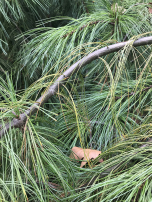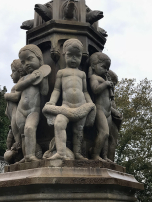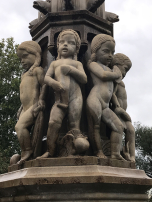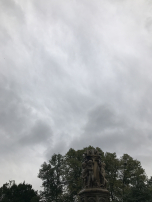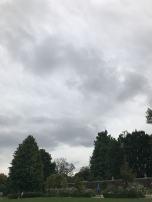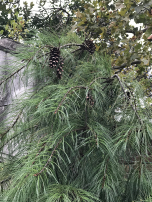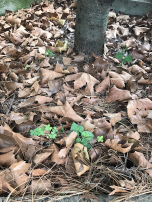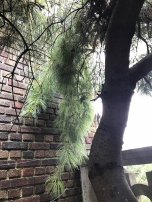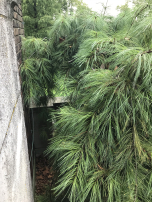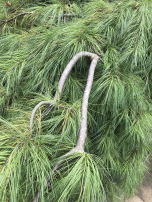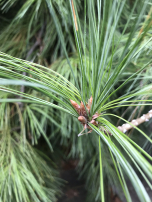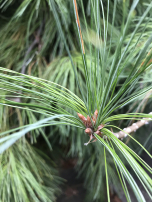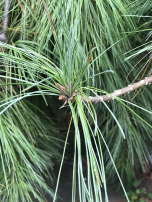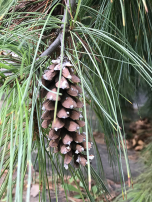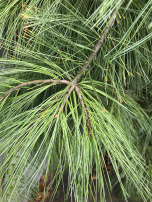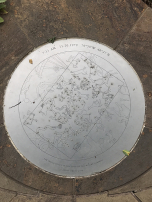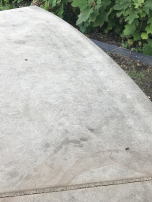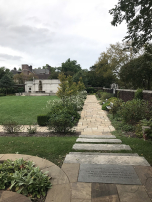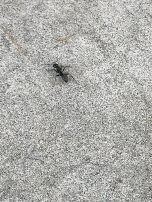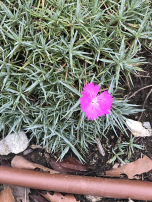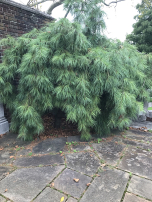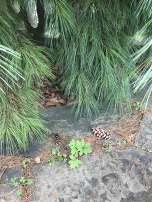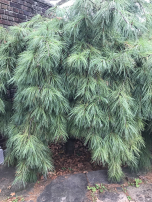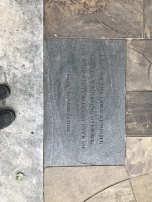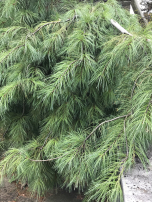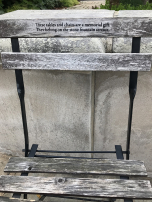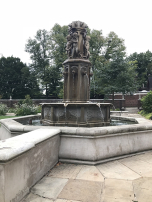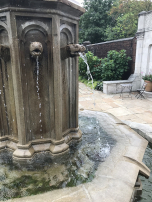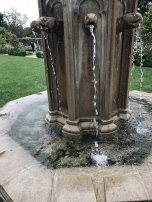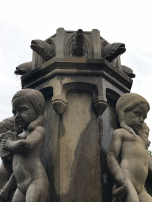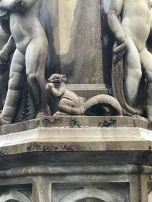it wasn’t roaring, it was weeping
(Entry #2)
Today is the autumnal equinox, an astronomical event that marks the beginning of fall in the northern hemisphere. Here in Pittsburgh, the weather has already acquiesced. The cloying heat of the past few weeks has relented — it is a brisk, breezy 61° F (16° C) as I walk to Mellon Park this afternoon. I am wearing the first long-sleeve shirt of the season — a dark teal Henley — and jeans. This is my favorite type of outfit, my favorite weather. Even the sky is perfect: overcast, a bright white canvas painted with the occasional gray cloud.
It is not rush hour, but it is a weekend. Traffic crowds Fifth Avenue, and it is hectic, loud and aggressive. As I cross Emerson Street, a car waits to turn left, its two passengers locked in a screaming battle over whether the driver could have already made the turn. Crowds of people shuffle along the sidewalk; joggers power past me, their hurry to get nowhere in particular a caricature of modern man’s plight. This, I remind myself, is why I usually wear headphones while I walk around the city.
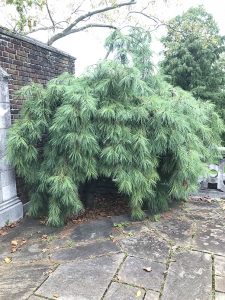 But like summer’s heat, all of that noise and hubbub melt away as soon as I get to Mellon Park. There are still people around — in fact, there’s an entire festival going on right now — but nobody rushes anywhere. There are no cars in sight; even better, I can’t even hear them now. I come into the park the same way every time I come here, through the northwestern gate, and each time I say hello to my favorite tree on the planet. I can’t say that I’ve met many trees — certainly not every tree on the planet! — but I’m still giving this one the title of favorite tree on the planet, because I like it that much.
But like summer’s heat, all of that noise and hubbub melt away as soon as I get to Mellon Park. There are still people around — in fact, there’s an entire festival going on right now — but nobody rushes anywhere. There are no cars in sight; even better, I can’t even hear them now. I come into the park the same way every time I come here, through the northwestern gate, and each time I say hello to my favorite tree on the planet. I can’t say that I’ve met many trees — certainly not every tree on the planet! — but I’m still giving this one the title of favorite tree on the planet, because I like it that much.
You may recall, if you read my first entry, that I first noticed this tree when I thought it looked like a portal to the land of Faerie. I could get on my hands and knees, crawl into that perfectly framed opening, and find myself suddenly in Narnia or Terabithia or Wonderland. (I’d prefer the third — the first is too religious for me, and the second traumatized me as a child.) This time, though, I don’t see a portal but a friendly, lumbering monster, a yeti made of pine needles instead of fur. (Later, I’ll ask my landscaper father what I kind of tree this is, and when I look up the species on the Internet, I will find at least two sites that refer to the weeping Eastern white pine as Snuffleupaguses, which is a perfect way to describe them.) Strangely enough, I still find myself imaging myself in that space, though now I’m being held in the arms of a BFG, like Sully from Monsters, Inc. or Willump from League of Legends. This, though, is a discussion I should have with a therapist, not an anonymous blog audience, and so I’ll leave it at that.
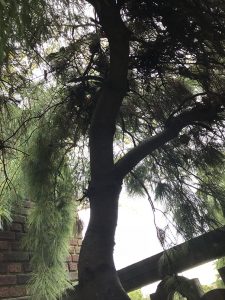 Let’s go back to the tree as portal, then. Last week, I was too self-conscious, too shy to climb through to Faerie Land. The tree and I had just met, after all, and I’m a bit old-fashioned when it comes to taking things slow. This week, though, I did get a bit more up close and personal with the tree. I knelt down before the gateway, jutted my head forward a bit, and took a look. Instantly I left Mellon Park; the tree was a portal after all! But I didn’t go to Faerie Land or Wonderland or even Narnia — I went back in time a few decades, to the summers when I was ten, eleven, twelve, and my grandmother’s house, which had a wall of enormous pine trees, fifteen or twenty trees that towered higher than the nearby telephone poles. My cousin and I used to play beneath them, imagining all sorts of scenarios, from survival games to fantasy adventures. Nick was born five months before me; we grew up together, cousins-cum-brothers of a sort. Our lives were like two stories read in tandem, one over the top of the other — the agonies of middle school, the turmoils of high school, coming out to our families (and ourselves), struggling through new adulthood. Over the past decade, Nick and I followed different paths, and we lost that closeness we once shared.
Let’s go back to the tree as portal, then. Last week, I was too self-conscious, too shy to climb through to Faerie Land. The tree and I had just met, after all, and I’m a bit old-fashioned when it comes to taking things slow. This week, though, I did get a bit more up close and personal with the tree. I knelt down before the gateway, jutted my head forward a bit, and took a look. Instantly I left Mellon Park; the tree was a portal after all! But I didn’t go to Faerie Land or Wonderland or even Narnia — I went back in time a few decades, to the summers when I was ten, eleven, twelve, and my grandmother’s house, which had a wall of enormous pine trees, fifteen or twenty trees that towered higher than the nearby telephone poles. My cousin and I used to play beneath them, imagining all sorts of scenarios, from survival games to fantasy adventures. Nick was born five months before me; we grew up together, cousins-cum-brothers of a sort. Our lives were like two stories read in tandem, one over the top of the other — the agonies of middle school, the turmoils of high school, coming out to our families (and ourselves), struggling through new adulthood. Over the past decade, Nick and I followed different paths, and we lost that closeness we once shared.
 I have not thought about those summer days under the pine trees in decades. They are a casualty of the way memory can group up so many individual moments into a single blur, moments that mattered so much at the time but tend to fade as time goes by. I think, perhaps, your mind assumes it will never forget seconds so important, and so it doesn’t try as hard as it should to keep track of them. It loses them in the shuffle of life, the way you lose that first birthday gift from your first serious boyfriend or that white puffball with googly-eyes and red felt feet that your fourth-grade teacher attached to your A+ spelling test. (You do remember, however, the day you realized you lost it. You were a senior in college, and you wore all black that day, and you have the pictures to prove it. Mourning came easily to you then.)
I have not thought about those summer days under the pine trees in decades. They are a casualty of the way memory can group up so many individual moments into a single blur, moments that mattered so much at the time but tend to fade as time goes by. I think, perhaps, your mind assumes it will never forget seconds so important, and so it doesn’t try as hard as it should to keep track of them. It loses them in the shuffle of life, the way you lose that first birthday gift from your first serious boyfriend or that white puffball with googly-eyes and red felt feet that your fourth-grade teacher attached to your A+ spelling test. (You do remember, however, the day you realized you lost it. You were a senior in college, and you wore all black that day, and you have the pictures to prove it. Mourning came easily to you then.)
Nick died this past April from a drug overdose; it was ruled an accident, but I have my doubts. Coping has been strange. Nick hadn’t been an active part of my life in years; in a way, he died to me years ago, when he fell head first and full steam ahead down a rabbit-hole and it didn’t lead to Wonderland. I have always actively avoided any and all white rabbits, especially if they wore timepieces and complained about being late. When Nick died, the strongest emotion I felt was relief. No more lies, no more late-night calls for money, no more uncomfortable family get-togethers. A decade of trouble had buried two decades of love, and it seemed that no amount of excavating would unearth them.
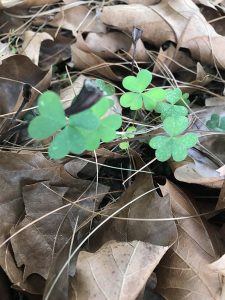 All it took, as it turns out, was this tree, this unexpected weeping white pine on the northwestern corner of Mellon Park in Pittsburgh, Pennsylvania to remind me of a life I had lived twenty-five miles and twenty-five years to the north. As I knelt in front of that tree, thoughts of my cousin and his death and the life he had lived before he died the first time on my mind, something — and I don’t know what exactly — just felt right. It was fall. I was kneeling at the foot of a tree whose branches had created a cradle, a portal to the past. Fallen leaves from the nearby deciduous trees had somehow swept beneath this pine, blanketing the ground with a memento mori. Through that blanket grew some clovers — weeds, really — that were just so bright, so alive, so green that it was hard to think only of death. Like my memories of the pines, these clovers had somehow fought through, had somehow pushed beyond the death and sadness and muck that tried to cover them. They are a memento, too, that death cannot exist without life, that the crunchy brown things in our lives can’t erase the bright green moments we’ve lived, and that even when the seasons change, what came before doesn’t disappear.
All it took, as it turns out, was this tree, this unexpected weeping white pine on the northwestern corner of Mellon Park in Pittsburgh, Pennsylvania to remind me of a life I had lived twenty-five miles and twenty-five years to the north. As I knelt in front of that tree, thoughts of my cousin and his death and the life he had lived before he died the first time on my mind, something — and I don’t know what exactly — just felt right. It was fall. I was kneeling at the foot of a tree whose branches had created a cradle, a portal to the past. Fallen leaves from the nearby deciduous trees had somehow swept beneath this pine, blanketing the ground with a memento mori. Through that blanket grew some clovers — weeds, really — that were just so bright, so alive, so green that it was hard to think only of death. Like my memories of the pines, these clovers had somehow fought through, had somehow pushed beyond the death and sadness and muck that tried to cover them. They are a memento, too, that death cannot exist without life, that the crunchy brown things in our lives can’t erase the bright green moments we’ve lived, and that even when the seasons change, what came before doesn’t disappear.
